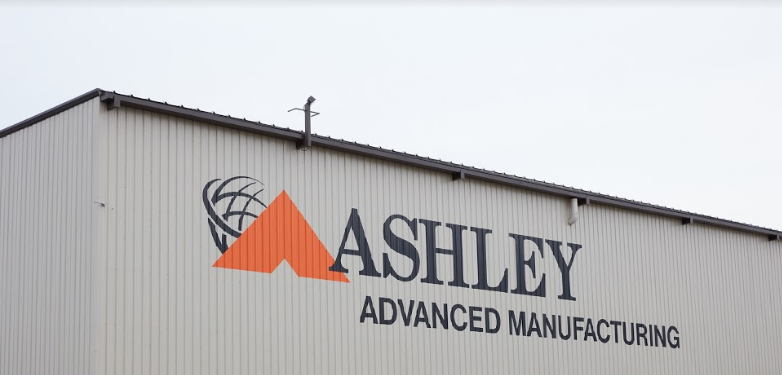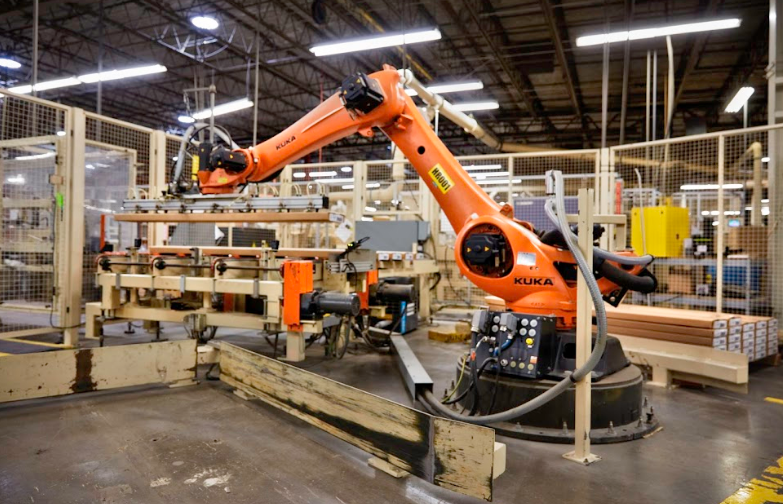Founded in 2005, Wisconsin-headquartered Ashley Furniture is a company known globally, beginning in 1970 with 35 employees, and growing now to over 900 stores. Ashley facilities manufacture over 300,000 pieces of furniture a week—and as operations move at a rapid pace, they not only focus on efficiency but also continued improvement and the ability to think of unique solutions to problems that may be typical.
 Factories rely on robots for some jobs, but 3D printing has ‘trickled onto the factory floor and gradually reorganized manufacturing processes from fabrication to assembly, continuing in line with their commitment to staying competitive and embracing progressive technologies, as well as combining them.
Factories rely on robots for some jobs, but 3D printing has ‘trickled onto the factory floor and gradually reorganized manufacturing processes from fabrication to assembly, continuing in line with their commitment to staying competitive and embracing progressive technologies, as well as combining them.
“If we don’t have that culture of change, that’s going to start to prohibit our growth. We have to be willing to identify what that change is going to be, and figure out how to best incorporate that into our processes and operations—and teach our employees why we need to make that change, how we can make it, and empower them to help us make it,” said Vaughn Pieters, senior director of casegood operations.
3D printing is a great example of the furniture leader’s commitment to better and more expedient production processes. The company has always been extremely willing to listen to employees with ideas—and especially those that cut time and costs and allow for more creativity and better productivity.
“We started out just making one simple sample, because we could make that sample in a matter of a few hours versus having to potentially source from an international vendor that would take weeks. We were able to use 3D printing technology to compress some of those timelines and make better more educated decisions with our design staff,” Pieters said.
“Now we’ve continued to grow that with how we use 3D printing technology to make components that help us run our day-to-day business on the manufacturing floor.”
3D printing allows the company to adapt components more easily to ‘end operator suggestions.’ And the more employees learn about 3D printing, the newer ideas they come up with, along with ways to improve productive further.
“The employee actually has the ability to say ‘Hey, I think that this idea will help us to make our process more efficient or effective.’ So that does us several things: it helps the business continue to be more efficient, more effective, and to get more product done in the same amount of time, and the employee gets a bonus for providing that information,” Pieters said.
“If you don’t have that employee buy-in at the ground level, the change is that much more difficult to become successful with. It’s a win-win, and it really helps keep our management and our employee team that much more connected. I think that the way we have such a great relationship all the way from our owners to our manufacturing floor employees and that open communication line does great things for our business.”
Because there have been such shortages of help, however, Ashley Furniture has had to learn more about technology like robotics and 3D printing and integrate it into their business. Their version of working smarter has been to offload heavy, physical work to robots, while employees are able to work and use their minds. 3D printing also allows for enormous savings in time, such as when introducing a new SKU, and company engineers can adapt a design quickly for production.
“We’ve literally replaced fixtures that are three feet by six feet with a simple bin system; it’s a two-minute setup time,” Konkel said. “It frees up jig builders from repetitive task to work on more pressing issues, from busy work to looking at more challenging items.”
“Things like 3D printing and automation are making the job easier for the employee so that it’s not so heavy and not so industrial,” Pieters said.
Processes became much more streamlined when Ashley Furniture brought in the Formlabs Form 2 3D printer. More products could be created in house, and with better performance and surface quality. Both Formlabs 3D printers on-site currently run 40 hours a week.
“Having the Form 2 and the ability to 3D print parts has allowed us to steer away from some of the traditional ways that we develop fixturing and tooling,” Konkel said. “It gives us the ability to quickly adapt to any suggestions or to any needs that we have and create geometries that we’re not traditionally able to manufacture or machine. We’re able to do things that weren’t quite possible several years ago.”
3D printing has been built on people pushing boundaries, and it continues daily. The furniture business has been duly affected also as consumers are given the opportunity to virtual shop, use 3D printed connectors for modular designs, and enjoy futuristic pieces. What do you think of this news? Let us know your thoughts; join the discussion of this and other 3D printing topics at 3DPrintBoard.com.
[Source / Images: Ashley Furniture]Subscribe to Our Email Newsletter
Stay up-to-date on all the latest news from the 3D printing industry and receive information and offers from third party vendors.
Print Services
Upload your 3D Models and get them printed quickly and efficiently.
You May Also Like
3D Printing News Briefs, July 2, 2025: Copper Alloys, Defense Manufacturing, & More
We’re starting off with metals in today’s 3D Printing News Briefs, as Farsoon has unveiled a large-scale AM solution for copper alloys, and Meltio used its wire-laser metal solution to...
3DPOD 260: John Hart on VulcanForms, MIT, Desktop Metal and More
John Hart is a Professor at MIT; he´s also the director of the Laboratory for Manufacturing and Productivity as well as the director of the Center for Advanced Production Technologies....
3D Printing News Briefs, June 28, 2025: Defense Accelerator, Surgical Models, & More
In this weekend’s 3D Printing News Briefs, 3YOURMIND was selected to join an EU Defense Accelerator, and PTC has announced model-based definition (MBD) capabilities within Onshape. Finally, a study out...
EOS in India: AM’s Rising Star
EOS is doubling down on India. With a growing base of aerospace startups, new government policies, and a massive engineering workforce, India is quickly becoming one of the most important...




































